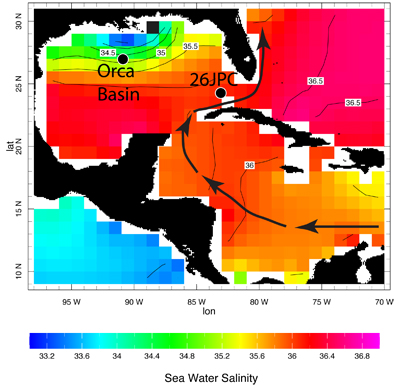Reconstructing the timing
of large-scale ocean and atmospheric circulation change
across the Younger Dryas
By:
Dr. Matthew Schmidt
Texas A&M University
| When: | Friday, Oct. 28, 2011, 10:30 a.m. to 11:30 a.m. Join us for coffee beginning at 10:00 a.m. |
| Where: | Seminar Conference Room, 10100 Burnet Road, Bldg 196-ROC, Austin, Texas 78758 |
| Host: | Charles Jackson, UTIG |

Abstract
The prevailing paradigm of abrupt climate change holds that rapid shifts associated with the most extreme climate swings of the last glacial cycle were forced by changes in the strength and northward extension of Atlantic Meridional Overturning Circulation (AMOC), resulting in an abrupt reorganization of atmospheric circulation patterns with global teleconnections.
To determine the timing of tropical Atlantic atmospheric circulation changes over the past 21 ka BP, we reconstruct high resolution sea surface temperature and d18OSW (a proxy for surface salinity) records based on Mg/Ca ratios and oxygen isotope measurements in the planktonic foraminifera Globigerinoides ruber from a sediment core located on the western margin of the Florida Straits. As a proxy for meltwater discharge influence on Florida Straits surface water salinity, we also measured Ba/Ca ratios in G. ruber from the same core. Results show that riverine influence on Florida Straits surface water started by 17.2 ka BP and ended by 13.6 ka BP, 600 years before the start of the Younger Dryas (YD) cold interval.
The initiation of the YD is marked by an abrupt increase in Florida Straits d18OSW values, indicating a shift to elevated sea surface salinity occurring in 130 years, most likely resulting from increased regional aridity and/or reduced precipitation. In order to resolve the timing of tropical atmospheric circulation change relative to AMOC variability across this transition, we compare the timing of surface water changes to a recently published record of Florida Current variability in the same core reconstructed from benthic oxygen isotope measurements [Lynch-Stieglitz et al., 2011].
We find synchronous changes in atmospheric and ocean circulation on the transition into the YD, consistent with an abrupt reduction in AMOC as the driver of tropical Atlantic atmospheric circulation change at this time.




